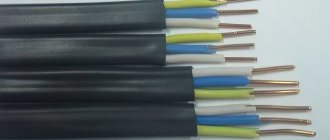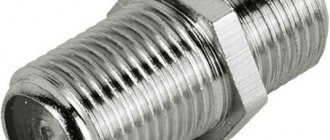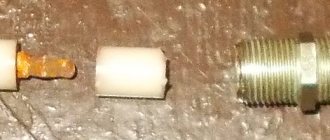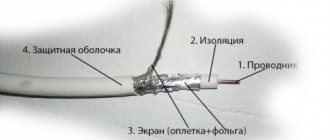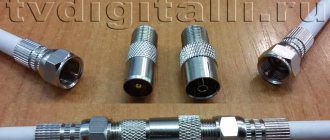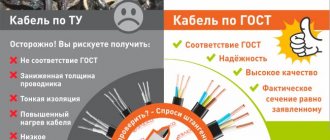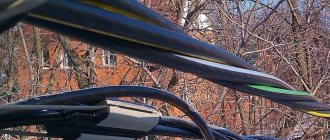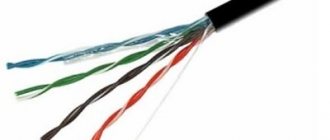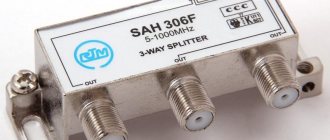In connection with the advent and popularization of digital and satellite broadcasting, the question increasingly arises of which television cable is better to choose. The relevance of the issue is more than justified, because the quality of the signal directly depends on the conductor.
When switching to satellite or digital television from analogue, quite often users encounter problems in the process of setting up individual channels. The picture quality leaves much to be desired. Naturally, this result runs counter to consumer expectations from modern equipment.
The main reason for failures and defects is the technical inadequacy of the old line in comparison with new signal reception technologies. That is why everyone should know how to choose the right cable for a TV.
Now we will carefully study the main features, and also give specific recommendations for choosing a conductor for satellite television. We will also dwell on the operating features, but let's start with the structure of the television cable.
The structure of a television cable
Speaking about the internal structure, we can say with certainty that all models have similar content.
- Inner conductor - it can be made as a single or stranded wire, copper tube. The signal range and possible bending radius depend on the material.
- Dielectric layer – ensures the immobility of conductors. It can be made of polyethylene, fluoroplastic, foamed polyvinyl chloride or an air layer. The characteristic impedance and attenuation of the transmitted signal depend on the quality of the material.
- The outer conductor is braided. Made from foil, corrugated tube, aluminum film, metal wire. The degree of protection from external electromagnetic interference depends on the quality of the material.
- A sheath that protects the internal structure of the cable.
As you can see, the principle of cable structure is the same, but the materials from which its structural parts are made differ from each other. How to choose a good option that matches the technical characteristics of modern television broadcasting?
The best antenna splitters for 2 TVs
To connect multiple TVs at once, use the best TV splitters. Let's look at them in more detail below.
PROconnect
This splitter is a coaxial option for satellite television with various quality characteristics. It can not only be used for two TVs, but also for interconnection and interconnection in public places. Can also be used to connect household radio devices or various types of surveillance cameras.
High-quality materials are used for production, which ensure stable data transmission without interference or distortion.
The outer covering is made of polyvinyl chloride, so you can install the splitter outdoors. It does not deform under the influence of ultraviolet radiation.
The length can be about 10, 20 and 50 m. There is a plug on each side for connection.
REXANT
This splitter model is used to connect several TVs or surveillance cameras. Total length – 100 m.
The splitter is characterized by high-quality insulation. Polyvinyl chloride was used for its manufacture. Black color. The disadvantage of this model is that it does not have connectors.
Now you know which antenna cable for satellite television is best to choose. It all depends on the installation location, the distance between the receiver and the receiver, the required signal quality, and price.
Expert opinion
It-Technology, Electrical power and electronics specialist
Ask questions to the “Specialist for modernization of energy generation systems”
A coaxial cable consists of: Using the right cable brands, good tools, components and connectors, installing a line yourself is not that difficult. Ask, I'm in touch!
How does a television cable work?
Analyzing the structural features, it is possible to say with a high probability that absolutely all models have approximately the same concept of internal structure:
- The inner conductor is made of solid wire, copper tubing, or multi-strand material. The quality of the material determines the signal reception distance, as well as the permissible bending indicator.
- The dielectric layer acts as a conductor clamp.
- The external conductor is braided. Often made of foil and thin wire. Quality affects the level of protection against external factors, such as electromagnetic interference.
- The inner sheath provides protection for absolutely all structural elements of the cable.
Thus, the types of television cables differ little in structure. Of course, there are certain features, but mainly they manifest themselves in the quality of the material from which this or that element is made.
Which TV cable is better to choose? The answer to this question directly depends on your goals. For example, if the signal distance is minimal, then there is no point in overpaying for an expensive coaxial cable conductor. In general, television cables and their varieties are universal, as they are suitable for satellite, digital and analogue broadcasting.
Lived
A central wire that resembles a core when cut crosswise. The composition is made of copper or alloys. The first option is preferable for safety reasons - copper is more susceptible to heating and has a high level of thermal conductivity. Consequently, if there is a short circuit or overcurrent is applied to the cable, rapid heating and an increase in resistance will occur, to which the TV fuse will immediately react. Steel alloys in this case will be less effective.
It is also advisable to choose a thicker core (~1 mm), because As the diameter increases, the attenuation coefficient decreases.
Screen
An outer conductor that prevents the signal from being attenuated by propagating outside the cable. Its functions are comparable to that of a satellite dish reflector. Today there are three screen options - foil, aluminum film and wire braid. The latter option for making a screen is less expensive and such cables are the cheapest. However, the outer wire is not solid, which greatly increases the attenuation coefficient. It is possible to use such a cable for digital television only when using an indoor antenna. Significant signal loss is guaranteed when the distance from the receiver to the TV is more than 1 m.
Foil and film are solid screens that reduce the attenuation coefficient to zero. This cable is recommended for connecting terrestrial and satellite television with an outdoor antenna. Foil would be preferable, but remember that it is not flexible and will break if bent too hard. If you choose to install an antenna on the roof of an apartment building, you need a long cable for wiring to the apartment and strong bends are planned, you will have to buy a cable for the most expensive TV, the screen of which consists of foil with a surface braid. In this case, it is used to protect the screen from damage at the bend points.
Shell
Insulating material made from HDPE or PVC. It can be white or black, less often gray. You can choose a cable for TV without being particularly interested in the casing, because... it does not affect the system characteristics of the cable. It is recommended to consider a denser material (since it is less susceptible to wear and heat), but within reasonable limits, because as it increases, flexibility decreases.
Plug
There are two types of plugs on the market: in a single design and in the format of a screw with a nut. In the latter case, it is enough to expose the cable and insert it inside the plug, then tighten it. This method is perfect for those who are not electrically versed and want to quickly connect the antenna wire. If you have the skills to use a soldering iron, it is safer to purchase a plug in a single design and solder the wires.
Choosing quality
So how will you check the cable quality? According to the following seven signs!
Purpose
External insulation not only resists external influences and mechanical damage - what it is made of largely determines the properties of the cable wire.
The most commonly used polyvinyl chloride coating for cable cords. You can choose them for wiring in the apartment. The coating made of light-stabilized polyethylene distinguishes the cords for outdoor use. In addition, outdoor cables have a protective gel-like layer against weather conditions and sunlight. By removing a section of insulation, you can see if there is a gel-like lubricant underneath that protects the inner surface of the cable from moisture.
Outer shell strength
Just try removing the outer layer by hand. If the PVC or PE coating is weak and easily slides off the braid or foil layer, lengthening and stretching, this no longer guarantees sufficient cable strength.
Quality of the shielding layer
The shielding layer is aluminum or copper foil wound onto a dielectric. Its task is to protect the signal passing inside the cable from external electromagnetic waves that can cause interference. It also prevents the signal from leaking out to prevent it from weakening. For both conditions to be met, the foil must be glued to the dielectric layer. This can be easily checked by removing part of the shell and examining the shielding layer. If the foil moves freely along the dielectric layer, this means that it was not glued, which means that during installation, when you need to bend the wire properly, the film will slightly open the dielectric and create an unprotected “gap” through which signals will penetrate.
You may be interested in: Connect digital television
Braid density
The most common braid is a copper or aluminum mesh made of wire with a diameter of about 0.12 mm. The higher the braid density (more wires), the higher the electromagnetic density of the cable. This is another barrier to protect the transmitted signal from interference.
At first glance, the density of the weave is difficult to assess. Pay attention to the interweaving of the hairs, at what angle? If they are laid freely, longitudinally, then we are dealing with a thin braid. And vice versa, if they form a dense mesh that covers the entire wire, then the braid coating is dense, “airtight”. The signal will be under reliable protection.
Dielectric check
The dielectric is a polymer layer made mainly of polyisobutylene. It is important that this material is foamed in a physical way. Chemical foaming does not have a long-term effect - after a few years the dielectric will collapse. A fragile dielectric means there is a 100% risk of displacement of the central core and loss of coaxiality. You cannot use such a wire for digital television.
Unfortunately, the nature of such foaming is difficult to analyze without special tools. But is it possible to check whether the dielectric is dense and whether it is well “welded” both to the core and to the foil (screen)? This is of key importance when bending the cable and determines its permissible bend radius.
Coax class
The cable class characterizes the degree of electromagnetic leakage. The higher the class, the greater its density and resistance to external interference. Higher tightness is achieved by choosing the type and number of screens and braids used. Cable wires are distinguished:
- two-layer – two layers inside: foil + braid;
- three-layer – foil + braid + foil;
- four-layer – braid + foil + braid + foil.
Of course, the greater the number of layers, the greater the electromagnetic density, the higher the class and quality of the cable wiring. To choose the right television cable, you need to see what class we are dealing with. It is enough to “clean” it layer by layer, reaching the dielectric.
Core type and thickness
The type of inner core and its thickness are directly related to the signal attenuation in the cable. Low attenuation cables maintain adequate signal quality throughout the entire length to the receiving device.
Coaxial cores can be made of copper or copper-plated steel. Copper has better conductive properties and reduces resistance to electrical charges. Therefore, it is more often used in various types of cables. In turn, the diameter of the wire increases the active conducting surface and reduces the resistance to these charges.
If the core is soft and does not change color after a small scrape or cut, you can be sure that you are dealing with copper wire. However, if the center wire is rigid, and after cleaning the top layer of copper the silver color of the steel clearly appears, then you have a copper-plated wire.
You may be interested in: How to connect two TVs to one antenna
Marking
When you buy a domestic product, there are usually no difficulties with its designation.
- RK – radio frequency cable;
- 75 – conductor resistance 75 Ohm;
- 4.8 – diameter;
- 34 – the first digit shows the insulation group, heat resistance category. The second digit is the serial number of the development;
- TU – technical manufacturing conditions.
But the labeling of imported cables can be confusing. Meanwhile, here is the definition of Western standards:
- DELINK – manufacturer;
- SAT-752 – name;
- Cu/Cu – material of the central conductor and braid (Cuprum – copper);
- 1.13 – thickness of the central core;
- 0.12*64 – thickness and density of the braid;
- Cu-foil – full copper;
- Coaxial cable – coaxial cable;
- 75 OHM – conductor resistance 75 Ohm;
- ISO 9001—2000 – certificate of conformity.
Crimp connection
A screw connection is made without the use of a special tool, but a connection with a crimp connector is considered better. The tight contact obtained during crimping ensures more reliable signal reception. If you have a special tool, the question of how to crimp a coaxial cable for a TV can be solved very simply.
Crimp connection technology:
- Place the crimp ring on the cable and trim the insulation 6mm from the edge.
- Expose the inner conductor, being careful not to damage it.
- Insert the center conductor into the connector, and then slide the crimp ring onto the connector pad.
- Using special crimping pliers, clamp the ring so that the transmitting core is pressed tightly against the connector contact.
- Remove any excess conductor protruding from the connector.
What is important when choosing
The choice of cable for a TV antenna is based on 7 main factors:
- Outer shell material. In the production of feeders, two options are used - PVC and light-stabilized (that is, resistant to ultraviolet rays) polyethylene. PVC is ideal for use inside an apartment (for example, when connecting to a communal antenna or cable TV). But for external laying nothing better than polyethylene has yet been invented. An unsuitable type of coating will lead to cable damage and breakdown.
- Strength of the outer layer. It is enough to try the outer PE or PVC sheath on a section of the feeder by pulling it towards you. If it moves easily, there is no need to use the cable: bending may damage the screen.
- The length of the route along which the cable channel will pass. The longer, the greater the loss of signal power due to conductor resistance. Therefore, where you need to lay a long route (10 m or more), it is better to use a cable with a copper central core rather than a steel one;
- Incoming signal power. Reception of terrestrial relay television broadcasts of the DVB-T2 standard provides the equipment with sufficiently powerful impulses, the same applies to cable TV. But the signal strength coming from the satellite is low. Therefore, for dishes it is better to choose cables with a copper core.
- Diameter of the central core. The thicker it is, the less loss during signal transmission. However, conductors that are too thick may require special adapters in order to be used in standard connectors.
- Cable thickness. Typically, the more powerful the feeder, the more layers of shielding are used, the thicker the central core and the more reliable the insulation. However, this is only an indicative sign. A high-quality, thin cord may be better suited for installation than a thick, low-quality cord. We'll talk about this below.
- Material of the central core. Copper transmits the signal better, clad steel is stronger. It’s easy to check what the core is made of: you need to take a magnet and bring it to the cable. If there is attraction, it means steel, if there is no attraction, it means copper.
Additionally, you can look for the following signs:
- Reviews of specific brands. It’s better to look at TV master forums rather than in online stores: there’s a greater chance that a particular review was not paid for, but was compiled on the basis of practical experience.
- Manufacturer. There are several brands whose products have no complaints (for example, the Italian company Cavel). For others, you need to look at the parameters of a specific brand.
What cable parameters should you pay attention to?
Insulated metal strands that conduct information to video and audio-reproducing connected equipment are characterized by several parameters. These include:
- conductor cross-section and material;
- signal attenuation and gain coefficient;
- wave resistance.
To transmit digital information, the wire resistance must be observed. It must be at least 75 ohms. The cable cross-section depends on the distance to the signal receiver. For example, for a multi-storey building, an average of at least 30 meters is typical. Then the conductor should be about 1 mm in diameter. If this is a private house, then a cross-sectional area of 0.5-0.9 square meters is sufficient. mm.
Regarding the material, both copper, steel, aluminum, and copper-plated alloys cope with conductivity. But manufacturers do not always provide information about attenuation, but this happens rarely. More often than not, the signal amplification factor is sufficient. For good quality, 60-80 dB is enough; with a footage of more than 25 meters, it will be possible to achieve an ideal image with a value exceeding 90 dB. But this is not always necessary.
The last criterion on which the choice of wire is based is the allowable flexibility of the cable. If it contains a core with a cross-section of less than 1 mm and the screen is represented by foil or film, then the risk of fracture of the core and screen increases already at an angle of 45⁰. This phenomenon is eliminated by a thicker core and additional metal braid.
Let's sum it up
If the time has come to choose, it is better to choose the cable that fulfills all the mentioned conditions:
- the thickness of the inner core exceeds 1 mm;
- the shielding film is glued to a physically foamed dielectric;
- has triple or quadruple insulation;
- braid density of at least 64% (densely spaced wires with a thickness of at least 0.12 mm);
- the coating of the outer insulating layer is adapted to the purpose of the cable;
- the maximum attenuation at frequencies of 862 MHz and 2150 MHz is respectively lower: 21 dB and 32 dB (parameter for 100 meters of wire).
By choosing an antenna cable according to these rules, you can be sure that you are dealing with an excellent quality product that you can count on when installing cables for both analogue and digital TV.
Choosing a cable for digital TV
Today on trading platforms you can find many options that meet certain parameters for high-quality digital television. But only a few of them meet all the requirements. Here are some examples:
- Inexpensive wire from China, Russian design. A copper-plated steel conductor or only a copper conductor transmits the signal quite well. It is labeled as RG-6U. The overall diameter is just under 7mm. The flexible antenna
cable has a resistance of about 9 dB per 100 linear meters. But the weak point is the PVC shell, which limits the scope of application to the internal lining in a heated room with constant humidity. - The domestic analogue of RK-75 is represented by a variety of cores ranging from 0.75 to 1.63 square meters. mm in cross section. Among the recommendations, the application is monitored for a satellite
signal with a relatively thick conductor (from 1 sq. mm). The cable is approved for installation in conditions of -/+ 60 degrees Celsius and the flexibility of the sheath is less susceptible to cracking. - Italian technologists presented the Sat-50 cable with a copper core with a diameter of about 1 mm. This is a high-quality coaxial
conductor, which is surrounded by an aluminum and foil screen. They compensate for interference and enhance the signal by an average of 60 dB. The declared service life is 15 years, taking into account the climatic conditions of central Russia outside. - Sat-703 in the cross-section of the core is increased by 0.13 square meters. mm and is more often used for wiring cables over 50 m long. Here the gain is 80 dB, which allows you to distribute information over several points without loss of quality. The sheath corresponds to the aggressive behavior of nature, so laying such a wire inside the building is not necessary from the point of view of economy.
- DG-113 is designed for transmitting any signal: digital, satellite, cable
television.
Its characteristics
are higher than those listed due to copper braiding and double foil. The coefficient is 90 dB. At the same time, the total cross-sectional area of the wire is only 1.13 square meters. mm. the durability of such a cable is also superior to analogues both for internal and external installation.
There is another option suitable for digital broadcasting. RG-59 has a thin core with a cross-section of up to 0.58 mm. This cable can only be used indoors with a minimum number of turns. This is explained by the fragility of the core and the high signal attenuation coefficient. If there is more than one TV in the house, then it is better to choose RG-6U.
Popular types of products
An indicator of the quality of a cable is its cost. Available options are more picky about operating conditions, while expensive solutions are not afraid of frost, heat, or nearby electrical appliances.
RG-6U
The affordable price tag makes this option extremely popular. Depending on the specific manufacturer, the conductor is either bare metal or copper-plated and with a cross-section from 0.724 to 0.816 mm2. The wire is protected from the outside with PVC insulation, under which there is a polyurethane dielectric. The thickness of the latter varies around 4.5-5 mm. The cable itself has a diameter of no more than 7 mm.
One of the clear advantages of RG-6 is its flexibility: it is easy to pull the cable through difficult angles. Another plus is the low attenuation rate - only 9.2 dB.
RG-6 is picky about temperature changes, so it cannot be laid outside the house. Thin PVC insulation will crumble after the first winter or melt in the hot summer under direct sunlight. High humidity also negatively affects the performance of the product.
Prices for RG-6U start at 10 rubles per meter.
RK-75
This is the closest analogue of RG-6U from a domestic manufacturer. The cable has an impressive number of varieties: a large selection of braids, screens and cross-sections. The latter can vary widely - from 0.75 to 1.63 mm2.
The conductor braid is made of tinned copper, and the insulation is made of reinforced PVC. Unlike RG-6U, RK-75 withstands low and high temperatures – from -60 to +60С⁰. The cable is also resistant to direct sunlight and high humidity. But it is slightly inferior to RG-6U in terms of bending (the angle margin is at least 3 cm), so it is not suitable for bypassing narrow door frames.
Prices for RK-75 start at 15 rubles per meter.
SAT-50
This is the brainchild of the European company Cavel. The cable is designed for transmitting high-frequency content. The conductor cross-section is around 1 mm2. Thin (0.12 mm2) aluminum threads shielded by several layers of foil are used as protection against external interference. At the same time, the signal improvement indicator is within 60 dB. The activity of household electrical appliances does not affect the operation of the cable in any way, with the exception of high-power vacuum cleaners.
The wire diameter is 6.6 mm. Insulating protection withstands direct sunlight, rain and snow and sudden temperature changes. The cable is well suited for outdoor installation.
The manufacturer promises up to 15 years of uninterrupted operation of the product in the absence of critical kinks.
The cost of SAT-50 is around 40 rubles per meter.
SAT-703
This is a more advanced version of the previous solution, designed for installation in difficult conditions and at significant distances from the receiver. The conductor cross-section has been increased to 1.13 mm2, as has the shielding. Even powerful models of household vacuum cleaners will not cause a specific background.
The signal amplification indicator of the SAT-703 is around 80 dB, which implies broadcasting without loss of quality, as well as the ability to connect several TVs using special splitters. The weak point of the product is the amount of bending. 43 mm will clearly not be enough for installation at home.
The price of SAT-703 is about 50 rubles per meter.
DG-113
This is the best this segment has to offer. The cable from the same company Cavel is designed to transmit a high-quality signal in any format. The gain indicator is around 90 dB. The product is perfectly shielded and eliminates the appearance of noise, artifacts and other background noise from household appliances.
Reliable braiding protects the cable from any climatic adversity: frost, heat, sun rays and water. The service life of the product is 15 years.
DG-113 is used in the most difficult cases, when you need to connect several TVs to one splitter, which is located outside the building. Running cable throughout the house is not practical given its price.
The cost of DG-113 is about 60 rubles per meter.
Choosing a cable for the main types of TV
There are several modern types of television broadcasting, ranging from terrestrial to satellite. The last type of TV will be discussed separately; as for the others, it makes no sense to select a cable separately for each type.
The broadcast frequency of cable channels, digital and terrestrial TV is in a fairly narrow range from 40 to 800 MHz. It is perfectly covered by all the listed brands. With a conductor length within 30 m, the loss of quality is almost unnoticeable even in inexpensive models. For this reason, you can safely purchase one cable for any television except satellite.
Coaxial cable design
Although coaxial cable may differ in conductor material and insulation quality, all types have approximately the same design:
- PVC insulation . It is resistant to ultraviolet radiation and protects the shielding layer and conductor from mechanical stress. May be black or white. Previously, black cable was intended for installation outside the window, and white cable inside the house. However, now manufacturers have moved away from such markings and now the insulation of almost every cable of any color can withstand environmental factors.
- Braided screen . The braid can be made of aluminum or copper wires. The thickness of each wire usually does not exceed 0.12 - 0.16 mm2.
- Foil screen . Along with the braiding, it protects the signal passing inside the wire from external interference. It can be single or double.
- Polyurethane dielectric.
- Conductor . The conductor can be made of pure copper or copper-plated steel. The first is more expensive and is usually used for satellite TV (although it is also suitable for others), while the second is cheaper and can be used for digital and terrestrial television broadcasting.
Choosing a cable for satellite TV
What kind of cable is needed for a satellite dish? The frequency of satellite channels plays a big role here; they are higher and the measurement takes place in thousands of megahertz. It is important to achieve transmission without significant loss of quality.
It is worth adding to this that the cable transmits special impulses and through it power is supplied to the converter. The quality loss of the satellite signal increases rapidly as the conductor lengthens. It is also quite sensitive to external interference.
For this reason, special requirements are placed on conductors for satellite TV. Only models SAT 703, DG 113 or similar characteristics can provide proper transmission conditions.
The general requirements for a cable for receiving satellite TV are as follows:
- the main core is made of copper;
- low signal attenuation;
- high quality outer shell.
The best TV cables according to reviews
The table shows products that enjoy well-deserved respect among professionals. Most of the technical characteristics of low current cables are taken into account, making the right choice easier. All types are coaxial type, most have universal use: in surveillance systems and for connecting to the Internet.
Depending on the cross-sectional diameter, the cables can be thin flexible (thin, resistance 50 Ohm, used for connecting local networks) or thick rigid (thick, Ø 12 mm, for transmitting signals over long distances). They are marked RG (Radio Guide scale), SAT (products of the Italian company CAVEL) or RK (domestic manufacturers of cables with a resistance of 75 Ohms and more).
RG-6
The cross-section of the central wire is 1 mm, it can be copper or copper-plated steel. Has two protective screens: aluminum foil and tinned copper. The domestic market contains mainly Chinese products.
Pros:
- Large range of types - can operate in the range up to 3 GHz, which expands the scope of use
- There are options with a steel core - stretching and sagging are reduced, the number of fixation points is reduced
- Shielding factor up to 90 dB – minimizes signal distortion
Minuses:
- Outer shell made of ordinary polymer - reacts extremely negatively to UV rays, only for indoor use
- The diameter of the core varies along the length - the cable must be purchased with a reserve cross-section
- Low parameters at frequencies ≤ 50 MHz – the quality of the digital picture noticeably deteriorates, not suitable for HDTV
RK 75
Analogue of RG-6 of domestic production. The copper central core is single-wire, thickness 1.0 mm. The insulating material is porous PE of physical foaming. The screen is made of copper braid or aluminum lavsan and tinned copper. The minimum cost per meter is 10 rubles.
Cable RK 75
RG-59
Universal cable (for digital and analogue television networks and video surveillance), the inner sheath is polyethylene, the outer sheath is polyvinyl chloride. The price is lower than RG-6, resistance is 75 Ohms. Screen made of copper wire, surface filling density 95%. Linear capacitance 53 pF/m, mismatch attenuation 20 dB.
Pros:
- Wide temperature range (-30°С–+80°С) – can be used in all climatic regions
- Copper center conductor - minimal resistance reduces signal power loss
- Diameter 6.2 mm - simplifies installation of networks in closed channels
Minuses:
- Bend radius 3 cm – difficulties arise when laying networks with complex geometries
- 2GHz Frequency Range – Application Options Are Reduced
- Core diameter 0.6 mm – losses increase critically at large distances
SAT-703
Core diameter 1.13 mm, PEG dielectric, minimum bending radius 35 mm, with multiple bending diameter increases to 70 mm. Allowable breaking force is 150 N. Class B shielding, loop resistance does not exceed 40 Ohms, maximum current does not exceed 8 A. Pros:
- High reliability indicators - the cable can be used for difficult operating conditions
- Minimum resistance - it is possible to increase the length of lines without loss of signal quality
Minuses:
- Great popularity among users - there are a lot of counterfeit unlicensed products on the market
- Large diameter - the weight of the feeder increases; additional measures must be taken during installation
SAT-50
The conductor is made of copper and has two screens (foil and copper wire). External insulation made of polyvinyl chloride, internal insulation made of polyethylene foam. Used to transmit digital and analogue television signals. External diameter 6.8 mm, resistance 75 Ohm, core diameter 1 mm.
Pros:
- Insulating shells made of modern innovative polymers – areas of use and installation methods are not limited
- Braided using new technology – increases screen efficiency
- Relatively low cost – increased availability for various consumers
- Stability of parameters along the length - simplifies calculations and improves signal quality
Minuses:
- Insufficient interference protection - not recommended for industrial use
- Thin outer shell – large distances between attachment points are not allowed
DG 113
Technical standards are close to SAT 703. An excellent option for a satellite dish inside a building. The wire has a high shielding value - from 90 dmb, which facilitates the transmission of high quality impulses. Failures and interference in operation are practically excluded. The average service life is more than ten years. It is considered the most expensive - from 65 rubles per meter.
Cable DG 113
Types of cable products for TV
The modern cable market is widely represented by various models. Therefore, when choosing the necessary connecting cable, you need to be well versed in some of the nuances of its application.
Depending on the purpose, connecting products can be divided into the following types.
The most common is coaxial cable for TV. Any television receiver is equipped with a special connector for connecting such a cable. And although analogue broadcasting is being replaced by digital television, coaxial cable is very often used to connect both indoor antennas and outdoor receiving devices.
Composite cable appeared with the development of video technology. Such a cable consists of three wires, one of which transmits a video signal, and the other two transmit an audio signal in stereo format. The connection is made in accordance with the color scheme on the pins and connector of the television receiver.
A component type cable transmits a digital satellite television signal. The connection is also made according to the colors of the contact pins.
High-definition video signals are transmitted via special HDMI and DVI cables. Cables of this type have become widespread with the development of computer technology. The first is translated as a high-definition multimedia interface.
Tips for use
To avoid premature wire failure, adhere to the following recommendations:
- When choosing an antenna cable to your TV for residential connection, you should buy a model with high wave capacity.
- For outdoor installations in regions with extreme weather conditions (abnormal heat, excessive temperature fluctuations, increased precipitation, too low temperatures), choose wires with special impregnation.
- During the installation process, you should not make too many solders and connections, as this will negatively affect the quality of the signal. Laying a single wire is the optimal solution.
- You should not use home-made splitters; it is more advisable to acquire a proprietary device. In addition, splitters and signal amplifiers should be located in accessible places - it is possible that a breakdown will occur over time, and repairs will be carried out accordingly.
- During the installation process, follow the manufacturer's recommendations. This is especially true for the bending radius and the distance between fasteners.
- Under no circumstances should a coaxial cable be laid close to electrical appliances - this may cause interference.
The expert advice offered will help you make the right choice. As a result, you will achieve the highest possible quality of connection to television equipment.
Sources
- https://tehnika.expert/cifrovaya/televizor/vybor-televizionnogo-kabelya.html
- https://ProSmartTV.ru/tehnologii/koaksialnyj-televizionnyj-kabel.html
- https://prosmartv.ru/receiving/televizionnyj-antennyj-kabel-dlya-tv.html
- https://tvdigitally.ru/efirnoe-tsifrovoe-televidenie/kakoj-kabel-luchshe-sem-prakticheskih-sposobov-proverki-kachestva
- https://ProDigTV.ru/efirnoe/antenna/kabel-dlya-tsifrovogo-televideniya
- https://cifrovoetv-rf.ru/digital-television-cable-which-is-better/
- https://resiverplus.ru/kakoj-kabel-nuzhen-dlya-antenny
- https://vyborok.ru/qa/electronics/televizionnyj-kabel-kakoj-luchshe.html
- https://teleinside.ru/antennyj-kabel-dlya-televizora/
